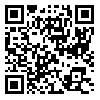Volume 26, Issue 1 (5-2020)
Back to this Issue |
Back to browse issues page
Download citation:
BibTeX | RIS | EndNote | Medlars | ProCite | Reference Manager | RefWorks
Send citation to:



BibTeX | RIS | EndNote | Medlars | ProCite | Reference Manager | RefWorks
Send citation to:
Sajadi M, Davodabady F, Zahedi S, Rafiei F. Comparison of the effect of diaphragmatic breathing and pursed lip breathing on anxiety in women undergoing hysterectomy. Journal of Hayat 2020; 26 (1) :72-83
URL: http://hayat.tums.ac.ir/article-1-3422-en.html
URL: http://hayat.tums.ac.ir/article-1-3422-en.html
1- Dept. of Pediatric of Nursing, School of Nursing, Arak University of Medical Sciences, Arak, Iran
2- Dept. of Medical Surgical Nursing, School of Nursing, Arak University of Medical Sciences, Arak, Iran ,Fahimedavodabady@gmail.com
3- Dept. of Medical Surgical Nursing, School of Nursing, Arak University of Medical Sciences, Arak, Iran
4- Dept. of Biostatistics and Epidemiology, School of Health, Tehran University of Medical Sciences, Tehran, Iran; Scientific Research Center, Tehran University of Medical Sciences, Tehran, Iran
2- Dept. of Medical Surgical Nursing, School of Nursing, Arak University of Medical Sciences, Arak, Iran ,
3- Dept. of Medical Surgical Nursing, School of Nursing, Arak University of Medical Sciences, Arak, Iran
4- Dept. of Biostatistics and Epidemiology, School of Health, Tehran University of Medical Sciences, Tehran, Iran; Scientific Research Center, Tehran University of Medical Sciences, Tehran, Iran
Abstract: (3279 Views)
Background & Aim: Hysterectomy is one of the most common surgeries in women, which causes many physical and psychological complications including anxiety. The aim of this study was to compare the effect of diaphragmatic breathing and pursed lip breathing on anxiety in women undergoing hysterectomy.
Methods & Materials: In this double-blind randomized controlled clinical trial, 126 patients referred to Taleghani hospital of Arak during 2017-2019 were selected by convenience sampling, and then assigned into three groups of diaphragmatic breathing, pursed lip breathing and control using the random number table. Anxiety was measured the evening before the operation (before the intervention), one hour before entering the operating room (after the intervention) and two hours after the operation, using the Spielberger Anxiety Questionnaire. Data were analyzed using descriptive and analytic statistics using the SPSS software version 16.
Results: The mean and standard deviation of anxiety scores for the diaphragmatic breathing, pursed lip breathing, and control groups were 55.33±10.49, 55.4±9.84, and 55.07±11.31 respectively, and there was no significant difference between the groups (P=0.983). One hour before going to the operating room (after the intervention), the mean and standard deviation of the anxiety score was 41.98±8.5, 42.43±7.88, and 52.86±11.5, respectively, and after the operation, the scores decreased to 37.79±8.13, 38.07±8.33 and 50.62±11.35 respectively. There was a significant difference between the three groups (P<0.0001). There was no statistically significant difference in the anxiety scores between the diaphragmatic breathing group and the pursed-lip breathing group after the intervention (P=0.999).
Conclusion: The results of this study showed the diaphragmatic breathing and pursed-lip breathing techniques are effective in reducing hysterectomy anxiety in women. Therefore, using this non-pharmacological approach is recommended to reduce anxiety before and after hysterectomy surgery.
Clinical trial registry: IRCT20180103038211N4
Methods & Materials: In this double-blind randomized controlled clinical trial, 126 patients referred to Taleghani hospital of Arak during 2017-2019 were selected by convenience sampling, and then assigned into three groups of diaphragmatic breathing, pursed lip breathing and control using the random number table. Anxiety was measured the evening before the operation (before the intervention), one hour before entering the operating room (after the intervention) and two hours after the operation, using the Spielberger Anxiety Questionnaire. Data were analyzed using descriptive and analytic statistics using the SPSS software version 16.
Results: The mean and standard deviation of anxiety scores for the diaphragmatic breathing, pursed lip breathing, and control groups were 55.33±10.49, 55.4±9.84, and 55.07±11.31 respectively, and there was no significant difference between the groups (P=0.983). One hour before going to the operating room (after the intervention), the mean and standard deviation of the anxiety score was 41.98±8.5, 42.43±7.88, and 52.86±11.5, respectively, and after the operation, the scores decreased to 37.79±8.13, 38.07±8.33 and 50.62±11.35 respectively. There was a significant difference between the three groups (P<0.0001). There was no statistically significant difference in the anxiety scores between the diaphragmatic breathing group and the pursed-lip breathing group after the intervention (P=0.999).
Conclusion: The results of this study showed the diaphragmatic breathing and pursed-lip breathing techniques are effective in reducing hysterectomy anxiety in women. Therefore, using this non-pharmacological approach is recommended to reduce anxiety before and after hysterectomy surgery.
Clinical trial registry: IRCT20180103038211N4
Send email to the article author
| Rights and permissions | |
 |
This work is licensed under a Creative Commons Attribution-NonCommercial 4.0 International License. |






